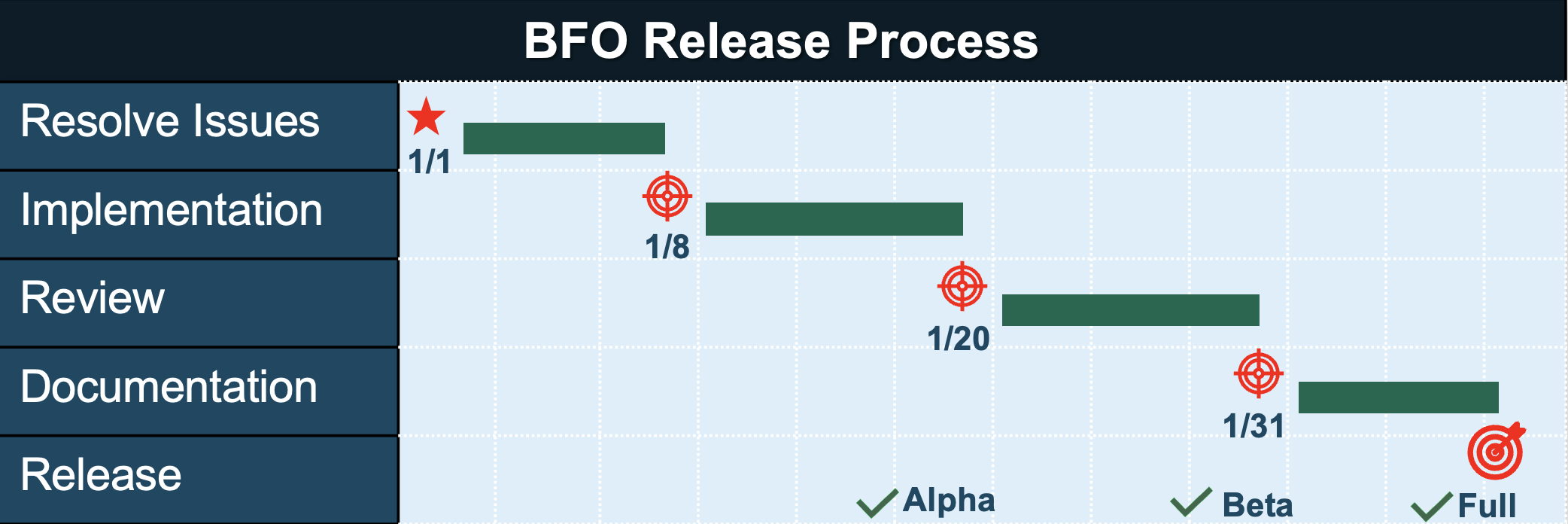This repository maintains the Basic Formal Ontology (BFO) artifact conformant to the requirements specified in ISO/IEC 21838‑1 for top-level ontologies. BFO contains classes and relations representing content common to all areas of scientific investigation, e.g. object, process, etc. and is used as a top-level architecture by numerous ontologies in the Open Biomedical and Biomedical Ontologies (OBO) Foundry, the Industrial Ontologies Foundry (IOF), and the Common Core Ontologies suite. Ontologies conformant to BFO promote interoperability, standardization, and reuse among domain-level ontologies.
The most current version is the "bfo-core.owl" file located at in this repository at: src/owl/bfo-core.owl
- documentation
- axiomatization pdfs - Contains first-order axiomatizations of BFO sub-theories stored in PDF, such as: continuant-mereology.pdf
- FAQ - Contains guidance for contributing to this repository, using Github workflows, and so on.
- images - Contains images used in this repository.
- user guides - Contains user guides for: ontology developers, software developers and subject matter experts.
- src
- owl - Contains the Web Ontology Language (OWL) implementation of BFO: bfo-core.owl.
- common logic - Contains the Common Logic Interchange Format (CLIF) implementation of BFO separated into files representing sub-theories of BFO, such as: material-entity.cl .
- prover9 - Contains an implementation of BFO that is readable by the Prover9 automated theorem prover, separated into files representing sub-theories of BFO, such as: temporal-region.prover9.
- sparql - Contains quality control checks written in the SPARQL Protocol and RDF Query Language (SPARQL) which are used to ensure updates to bfo-core.owl do not violate design principles, such as having exactly one skos:prefLabel per language: exactly_1_prefLabel_per_lang.sparql.
- temporal extensions - Contains R&D project extending bfo-core.owl to stronger representations of time, as well as supplementary documentatin supporting such extensions.
These documents are licensed under the terms of the Creative Commons Attribution 4.0 International (CC BY 4.0) license: https://creativecommons.org/licenses/by/4.0/ . The most current version of these files will be at https://github.com/BFO-ontology/BFO-2020
For further documentation concerning this repository, see the BFO Documentation Page.
For further information about building ontologies using BFO artifacts and strategies, see Building Ontologies with Basic Formal Ontology.
For example BFO design patterns, see the article Basic Formal Ontology: Case Studies.
For information about upcoming and past BFO events, see NCOR.
- Barry Smith, SUNY Distinguished Professor of Philosophy and Julian Park Chair, University at Buffalo, Department of Philosophy
- Alan Ruttenberg, Director of Clinical and Translational Data Exchange, University at Buffalo
- John Beverley, Assistant Professor, University at Buffalo
graph LR
A(Entity):::BFO --> B(Continuant)
B(Continuant):::BFO --> D(Specifically Dependent<br> Continuant)
B(Continuant) --> E(Generically Dependent<br> Continuant):::BFO
B(Continuant) --> F(Independent<br> Continuant)
F(Independent<br> Continuant):::BFO --> G(Material Entity)
F(Independent<br> Continuant) --> H(Immaterial<br> Entity)
D(Specifically Dependent<br> Continuant):::BFO --> I(Quality)
D(Specifically Dependent<br> Continuant) --> J(Realizable<br> Entity):::BFO
I(Quality):::BFO --> K(Relational<br> Quality):::BFO
J(Realizable<br> Entity):::BFO --> L(Role):::BFO
J(Realizable<br> Entity) --> M(Disposition):::BFO
M(Disposition) --> N(Function):::BFO
H(Immaterial<br> Entity):::BFO --> O(Site):::BFO
H(Immaterial<br> Entity) --> P(Spatial<br> Region):::BFO
H(Immaterial<br> Entity) --> Q(Continuant Fiat<br> Boundary):::BFO
Q(Continuant Fiat<br> Boundary):::BFO --> R(Fiat<br> Point):::BFO
Q(Continuant Fiat<br> Boundary) --> S(Fiat<br> Surface):::BFO
Q(Continuant Fiat<br> Boundary) --> T(Fiat<br> Line):::BFO
P(Spatial<br> Region):::BFO --> VD(Zero-Dimensional<br> Spatial Region):::BFO
P(Spatial<br> Region):::BFO --> U(One-Dimensional<br> Spatial Region):::BFO
P(Spatial<br> Region):::BFO --> V(Two-Dimensional<br> Spatial Region):::BFO
P(Spatial<br> Region):::BFO --> W(Three-Dimensional<br> Spatial Region):::BFO
G(Material<br> Entity):::BFO --> X(Fiat Object Part):::BFO
G(Material<br> Entity):::BFO --> Y(Object<br> Aggregate):::BFO
G(Material<br> Entity):::BFO --> Z(Object):::BFO
A(Entity):::BFO --> C(Occurrent):::BFO
C(Occurrent):::BFO --> AA(Process):::BFO
C(Occurrent) --> AB(Process<br> Boundary):::BFO
C(Occurrent) --> AC(Temporal<br> Region):::BFO
C(Occurrent) --> AD(Spatiotemporal<br> Region):::BFO
AA(Process):::BFO --> AE(History):::BFO
AC(Temporal<br> Region):::BFO --> AF(Zero-Dimensional<br> Temporal Region):::BFO
AC(Temporal<br> Region) --> AI(One-Dimensional<br> Temporal Region):::BFO
AF(Zero-Dimensional<br> Temporal Region):::BFO --> AG(Temporal<br> Instant):::BFO
AI(One-Dimensional<br> Temporal Region):::BFO --> AH(Temporal<br> Interval):::BFO
classDef BFO fill:#F5AD27,color:#060606
